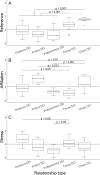Pet dogs' relationships vary rather individually than according to partner's species
- PMID: 30837560
- PMCID: PMC6401312
- DOI: 10.1038/s41598-019-40164-x
Pet dogs' relationships vary rather individually than according to partner's species
Abstract
Most dogs worldwide are free-ranging animals that form relationships mainly with conspecifics, yet research has focused mainly on the dog-human bond, leading to the hypothesis that dogs evolved specific abilities to form a unique relationship with humans. Although widespread, this hypothesis has not, as yet, been tested. Here we compared the relationships pet dogs form with their owner and with other dogs living in the same household. Using a bottom-up approach, we analyzed dogs' behavior in a test battery with both dog and human partners. Results revealed that pet dogs' relationships are characterized by three components (i.e. reference, affiliation and stress). A comparison between dogs' intra- and inter-specific relationships found that overall dogs refer more to their owner, but also that some dogs form stronger affiliative bonds with conspecifics than with their owner. Moreover, we tested how different partners could help dogs cope with a stressful situation. We found that the type of relationship, rather than the partner species, predicts how dogs react to a social threat. Our results suggest that dogs can form relationships of comparable qualities with both humans and other dogs, and that these relationships vary along multiple components across different partners.
Conflict of interest statement
The authors declare no competing interests.
Figures



Similar articles
-
Do dogs exhibit jealous behaviors when their owner attends to their companion dog?Anim Cogn. 2018 Sep;21(5):703-713. doi: 10.1007/s10071-018-1204-0. Epub 2018 Jul 26. Anim Cogn. 2018. PMID: 30051326
-
Agility and search and rescue training differently affects pet dogs' behaviour in socio-cognitive tasks.Behav Processes. 2009 Jul;81(3):416-22. doi: 10.1016/j.beproc.2009.03.015. Behav Processes. 2009. PMID: 19520242 Review.
-
Dogs and their human companions: the effect of familiarity on dog-human interactions.Behav Processes. 2015 Jan;110:27-36. doi: 10.1016/j.beproc.2014.02.005. Epub 2014 Feb 16. Behav Processes. 2015. PMID: 24548652
-
Associations between owner personality and psychological status and the prevalence of canine behavior problems.PLoS One. 2018 Feb 14;13(2):e0192846. doi: 10.1371/journal.pone.0192846. eCollection 2018. PLoS One. 2018. PMID: 29444154 Free PMC article.
-
How Dogs Perceive Humans and How Humans Should Treat Their Pet Dogs: Linking Cognition With Ethics.Front Psychol. 2020 Dec 16;11:584037. doi: 10.3389/fpsyg.2020.584037. eCollection 2020. Front Psychol. 2020. PMID: 33391102 Free PMC article. Review.
Cited by
-
Familiar Dog or Familiar Person: Who Do Pet Dogs Best Synchronize with?Animals (Basel). 2025 Feb 11;15(4):505. doi: 10.3390/ani15040505. Animals (Basel). 2025. PMID: 40002987 Free PMC article.
-
Overimitation in Dogs: Is There a Link to the Quality of the Relationship with the Caregiver?Animals (Basel). 2022 Jan 29;12(3):326. doi: 10.3390/ani12030326. Animals (Basel). 2022. PMID: 35158650 Free PMC article.
-
What Would You Do? Types of Ethical Challenging Situations Depicted in Vignettes Published in the Veterinary Literature from 1990 to 2020.Vet Sci. 2021 Dec 22;9(1):2. doi: 10.3390/vetsci9010002. Vet Sci. 2021. PMID: 35051086 Free PMC article.
-
Physiological Indicators of Acute and Chronic Stress in Securely and Insecurely Attached Dogs Undergoing a Strange Situation Procedure (SSP): Preliminary Results.Vet Sci. 2022 Sep 23;9(10):519. doi: 10.3390/vetsci9100519. Vet Sci. 2022. PMID: 36288132 Free PMC article.
-
Are children and dogs best friends? A scoping review to explore the positive and negative effects of child-dog interactions.PeerJ. 2022 Dec 19;10:e14532. doi: 10.7717/peerj.14532. eCollection 2022. PeerJ. 2022. PMID: 36570006 Free PMC article.
References
-
- Hughes J, Macdonald DW. A review of the interactions between free-roaming domestic dogs and wildlife. Biol. Conserv. 2013;157:341–351. doi: 10.1016/j.biocon.2012.07.005. - DOI
Publication types
MeSH terms
LinkOut - more resources
Full Text Sources

